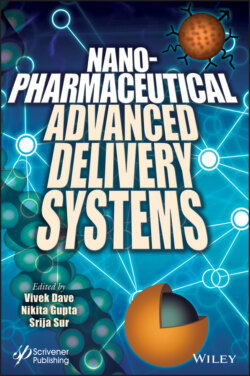Читать книгу Nanopharmaceutical Advanced Delivery Systems - Группа авторов - Страница 39
2.1 Introduction
ОглавлениеOne can witness the multitudinous furtherance made by researchers in the field of medicines. Multifarious research has been done in not just discovering new drugs and their targets but also casting the unique ways that could deliver the drug of interest to the desired site with maximum efficacy and minimal side effects. Novel drug delivery systems in relation to conventional drug delivery systems offer advantages of controlling the fate of drugs in the body with minimal fluctuations in plasma-drug concentration. Apart from these core advantages, they also provide target specificity, improved bioavailability, lesser side effects, and better absorption profile. Nanotechnology has opened newer avenues of applications of novel drug delivery systems by providing target specificity to the carriers achieved by engineering the surface of the carriers with moieties that can attach to receptors expressed abundantly by the diseased cells [1]. Nanoscience has revolutionized the field of drug delivery, tissue engineering, biosensors, and nano-biotechnology [2, 3]. Nanomaterials are considered as particles having size less than 100 nm in any one dimension. Based on this criterion, the nanomaterials are classified as zero-dimensional (0D), one-dimensional (1D), two-dimensional (2-D), and three-dimensional (3D). Particles are considered as 0-D nanomaterials when all the dimensions are in the nanoscale range, i.e., less than 100 nm. Two out of three dimensions in 1-D nanomaterials are in the nanoscale range (one dimension is in the macroscale range). Nanotubes, nanofibers, and nanorods are examples of 1-D nanomaterials. The 2-D nanomaterials have only one dimension in the nanoscale range; examples include nanofilms and nanocoatings. Bundles of nanotubes or nanorods, multilayer of nanofilms in which all the dimensions are in the macroscale range, are considered as 3-D nanomaterials [4].
Polymers (natural or synthetic), lipids, or metals are used in the preparation of nanoparticulate carriers, which impart characteristic properties to these carriers. The composition and method of preparation of nanocarriers define the micromeritics, surface morphology, chemical properties, mechanical properties, magnetic properties, conductivity, and stability [1] Owing to their nanosize, these carriers can be transported via active or passive mechanisms across the biological barriers/tissues/cells and deliver drug at the target site [2, 3]. Endocytic absorption of nanocarriers is one such mechanism that results in improved bioavailability of drugs, especially the poorly soluble ones. Alongside drugs, nanocarriers are also being used for delivery of genetic material, viz. DNA or RNA [5].
